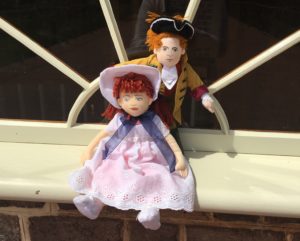Restoration Process
Research
Poplar Forest constitutes one of largest new sources of information in the twentieth century about Jefferson’s life and work. While mention of Poplar Forest was scattered throughout many of Jefferson’s letters and records, never before had this disparate material been systematically researched and compiled to reveal the full extent and significance of this site.
Jefferson wrote letters to his workers at Poplar Forest instructing them in every building detail. This one describes the flat “terras” roof for the main house.
S. Allen Chambers researched all known Jefferson sources for several years before writing the award-winning definitive history Poplar Forest and Thomas Jefferson.
Documentary research into the incredibly rich written legacy of Thomas Jefferson began in 1986 under contract with S. Allen Chambers, Architectural Historian. Chambers compiled his research into the award-winning definitive history, Poplar Forest and Thomas Jefferson.
Repositories spanning the country from Boston to Florida to California were researched for Jefferson items in addition to the Jefferson major repositories at the Library of Congress, the University of Virginia and the Massachusetts Historical Society. Every letter written about Poplar Forest, letters written from or to Poplar Forest, and letters or documents related to Poplar Forest were transcribed and digitized at Poplar Forest in 1989. More than 1,200 documents were then studied prior to any restoration investigation work.
While not many of Jefferson’s more than 700 architectural drawings are of Poplar Forest, they still provide useful information about common details used by him at Poplar Forest. More important is the extensive and explicit correspondence between President Jefferson at the White House in Washington and the free and enslaved workers building Poplar Forest. This two-way dialogue between architect/owner and workers regarding design, materials, and choices makes this the most uniquely documented private construction project of the eighteenth- or early- nineteenth century in America, Monticello being the only exception. Jefferson’s famous habit of documentation in many forms was extended through the use of his polygraph machine, creating two letters at one time and allowing him to keep one copy.
In addition, the unpublished manuscript of Thomas Jefferson’s daily Memoranda Book (1767-1826) was made available to the corporation through Monticello and Princeton University Press. This very detailed daily account of Jefferson’s life, annotated by James Bear and Lucia Stanton, is now a published work.
S. Allen Chambers extended his research into the Cobbs and Hutter families who lived in the house from 1828-1946. Letters, and a daily farm journal from 1844-1854, offer invaluable insight into the different lifestyle and uses of the property after Jefferson’s time. Oral interviews have been conducted on members of the Hutter and Watts families as well as farm and house workers who worked for both families.
Research conducted by historian Lee Marmon into local legal records at the county courthouses and at the state archives yielded many facts pertaining to many facets of the property’s history spanning the early 18th century to the mid-20th century, including: real estate transactions, tax records, court cases, mercantile connections, neighbors, plantation overseers, plantation slaves, the Jefferson family, the Eppes Family, the Cobbs family, the Hutter family, and the Watts family.
Academic Theses
Three masters theses on Poplar Forest have been completed at the University of Virginia School of Architecture: C. Allan Brown, “Poplar Forest: Thomas Jefferson and the Ideal Villa,” UVA Landscape Architecture 1987; Amy E. Facca, “Thomas Jefferson’s Poplar Forest [about the uses of octagonal forms and the Tuscan Order],” UVA Architectural History 1988; Ann M. Lucas, “Ordering His Environment [about Jefferson’s design of service structures],” UVA Architectural History 1989.
Documentation
As a first step in documenting the property, the main house, outbuildings and site were recorded in 1985 through measured drawings by the Historic American Buildings Survey of the National Park Service. The drawings and professional photographs which resulted from this effort provide one type of record of the pre-restoration condition of the property. These drawings and photographs are stored at the Library of Congress.

- For his landscape, Jefferson incorporated unique elements to fit the design of the retreat.
- Find Jefferson where these elements are discussed in detail from the perspective of both Jefferson and our archaeologists.